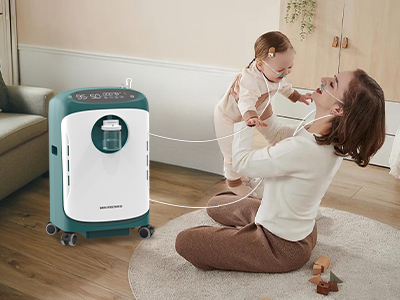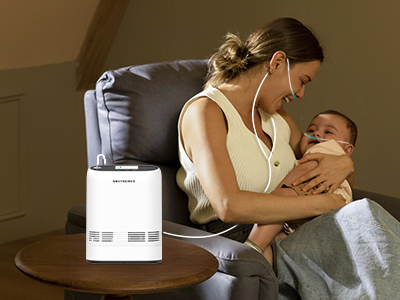07 Jul 2025
Home oxygen therapy for preemies isn’t just a medical routine; it’s a lifestyle remix. It’s learning how to cuddle without tangling cords, how to sleep while listening to concentrator hums, and how to pack a diaper bag with the precision of a military field medic. But most of all, it’s a path toward stronger lungs, bigger breaths, and thriving life outside the NICU.

Why Preemies Might Need Oxygen After Hospital Discharge
Preemies, with their fabulous sense of urgency, often skip some crucial lung development before birth. The final weeks of gestation are when the lungs mature, fill with surfactant, and get ready to breathe like a pro. If a baby misses out on that window, the result is often undercooked lungs—tiny, sticky, and easily overwhelmed.
Common reasons for continued oxygen therapy at home include:
Bronchopulmonary Dysplasia (BPD): A fancy name for the not-so-fancy reality of inflamed, stiff lungs needing extra support.
Apnea of Prematurity: When little brains briefly forget to tell the lungs to breathe—rude.
Pulmonary Hypertension: High blood pressure in the lungs that makes oxygen transfer tricky.
Residual Lung Immaturity: Sometimes lungs just need a bit more time to catch up—like a late bloomer at a high school reunion.
Oxygen at home helps these babies grow without their bodies constantly playing catch-up. It’s not a step backward—it’s a high-tech booster seat for breathing.
The Home Setup: Less Hospital, More Cozy Fortress
Gone are the sterile white walls and beeping monitors of the NICU. Now it’s up to you to turn your living room into a mini respiratory haven—with plush blankets and a hint of clinical chic.
The Essentials:
Oxygen Source: Either tanks (portable and ready for action) or concentrators (hum softly in a corner like a meditative air purifier).
Tubing and Cannula: Think of this as your baby’s oxygen highway—soft, flexible, and occasionally a tripping hazard.
Humidifier Bottle (optional): Helps moisten the air to prevent dried-out little noses. Pro tip: use distilled water—your tap water is not invited.
Pulse Oximeter: A tiny device with a big job. It clips to a foot or hand and tells you how well your baby’s getting oxygen, so you don’t have to guess.
A neat little “oxygen station” in your home—organized, labeled, and away from curious pets or rogue toddlers—is a life upgrade disguised as a safety measure.
Daily Life With Tubes, Beeps, and Baby Gurgles
At first, it feels like a juggling act performed on a tightrope during an earthquake. But soon, you’re managing cords like a seasoned roadie on a world tour.
Feeding Time: Tube placement matters. Secure it with soft tape. Avoid kinks. And if baby’s chewing it like licorice, it might be time for a pacifier swap.
Bath Time: Oxygen stays far, far away. Use tanks if portable, or remove cannula briefly with pediatrician’s approval. Sponge baths are safer than slippery aquatic Olympics.
Outings: Yes, you can leave the house. Portable tanks, backup cannulas, oximeter, diaper bag, snacks for you—you’ve got this. Just allow 20 extra minutes for prep. (Okay, maybe 40.)
Sleep Time: Many babies still need oxygen while sleeping. Secure tubing with care, check the oximeter occasionally, and rest knowing that your little one is breathing easier.
There’s a rhythm to it all. And once you find it, the days get lighter. Not tubing-free—but definitely less tangled.
Monitoring Oxygen Levels and When to Call the Doctor
Let’s talk about the pulse oximeter—your pocket-sized oracle.
What to Watch For:
Normal Range: Your doctor will set your baby’s target saturation level. Typically, it hovers around 90–95%, but your neonatologist may aim higher or lower depending on conditions.
Alarms: These can be triggered by motion, cold feet, or the baby’s new hobby: toe wrestling with the sensor. But frequent drops or slow recovery? Call the doc.
Color Changes: Blue lips or unusually pale skin = 🚨. It might mean your baby isn’t oxygenating well.
Always have a “just in case” checklist:
Pediatrician’s number, emergency oxygen tank, closest pediatric ER location (that’s oxygen-aware)

Weaning Off: The Glorious Countdown to Tube Freedom
The day you ditch the tubing is cause for confetti. But like all great transformations, it happens gradually—and with much fanfare from your medical team.
Weaning involves:
Room Air Trials: Brief periods where oxygen is removed while monitoring O₂ levels.
Growth and Weight Gains: Bigger lungs mean better function. Your baby’s chubbier cheeks are doing more than just being cute.
Sleep Studies: To ensure oxygen levels stay stable overnight when things get trickier.
Doctors may reduce flow rates bit by bit, reassess often, and cheer you on like a respiratory relay team. The goal: no dips, no distress, no more tubing.
Emotional Realities: From NICU Warrior to Home Oxygen Hero
There’s a quiet kind of bravery required to parent a baby on oxygen at home. It’s invisible to strangers but deeply felt.
You might feel:
Worried 24/7: Totally normal. But trust—the beeps, sensors, and careful prep are there for protection.
Exhausted: It’s okay to nap while the machine hums. You’re not being lazy—you’re recharging.
Isolated: It can feel like other parents don’t get it. (Spoiler: they don’t.) Join preemie support groups. Share your wins. Vent your tangled tubing woes.
Remember—this chapter doesn’t last forever. And you're doing a remarkable job guiding your child through it.
Keywords: oxygen therapy
Originally published 07 Jul 2025, updated 07 Jul 2025.